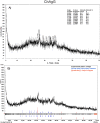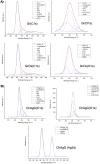Antibacterial nanocomposite of chitosan/silver nanocrystals/graphene oxide (ChAgG) development for its potential use in bioactive wound dressings
- PMID: 37353546
- PMCID: PMC10290094
- DOI: 10.1038/s41598-023-29015-y
Antibacterial nanocomposite of chitosan/silver nanocrystals/graphene oxide (ChAgG) development for its potential use in bioactive wound dressings
Abstract
An adequate wound dressing reduces time of healing, provides cost-effective care, thereby improving patients' quality life. An antimicrobial bioactivity is always desired, for that reason, the objective of this work is to design an antimicrobial nanocomposite of chitosan/silver nanocrystals/graphene oxide (ChAgG). ChAgG nanostructured composite material is composed of chitosan from corn (Ch), and silver nanocrystals from garlic (Allium sativum). The nanocomposite obtained is the result of a series of experiments combining the graphene oxide (GrOx) with two members of the Amaryllidaceae family; garlic and onion (Allium cebae), which contain different sulfur materials. The characterization arrays confirmed the successful production of silver crystal, graphene oxidation and the blending of both components. The role of the chitosan as a binder between graphene and silver nanocrystals is proved. Moreover, the study discusses garlic as an optimal source that permits the synthesis of silver nanocrystals (AgNCs) (⁓ 2 to 10 nm) with better thermal and crystallinity properties. It was also confirmed the successful production of the ChAgG nanocomposite. Escherichia coli and Staphylococcus aureus were used to demonstrate the antibacterial bioactivity and L-929 fibroblast cells were utilized to visualize their biocompatibility. The proposed ChAgG nanomaterial will be useful for functionalizing specific fiber network that represents current challenging research in the fabrication of bioactive wound dressings.
© 2023. The Author(s).
Conflict of interest statement
The authors declare no competing interests.
Figures






Similar articles
-
Integrating an antimicrobial nanocomposite to bioactive electrospun fibers for improved wound dressing materials.Sci Rep. 2024 Oct 24;14(1):25118. doi: 10.1038/s41598-024-75814-2. Sci Rep. 2024. PMID: 39443526 Free PMC article.
-
A sandwich-like chitosan-based antibacterial nanocomposite film with reduced graphene oxide immobilized silver nanoparticles.Carbohydr Polym. 2021 May 15;260:117835. doi: 10.1016/j.carbpol.2021.117835. Epub 2021 Feb 18. Carbohydr Polym. 2021. PMID: 33712172
-
Study and evaluation of a gelatin- silver oxide nanoparticles releasing nitric oxide production of wound healing dressing for diabetic ulcer.PLoS One. 2024 Jun 17;19(6):e0298124. doi: 10.1371/journal.pone.0298124. eCollection 2024. PLoS One. 2024. PMID: 38885218 Free PMC article.
-
Carbohydrate polymer-based silver nanocomposites: Recent progress in the antimicrobial wound dressings.Carbohydr Polym. 2020 Mar 1;231:115696. doi: 10.1016/j.carbpol.2019.115696. Epub 2019 Nov 29. Carbohydr Polym. 2020. PMID: 31888835 Review.
-
Cellulose-Silver Composites Materials: Preparation and Applications.Biomolecules. 2021 Nov 12;11(11):1684. doi: 10.3390/biom11111684. Biomolecules. 2021. PMID: 34827681 Free PMC article. Review.
Cited by
-
Effect of Graphene Oxide and Silver Nanoparticle Hybrid Composite on Acinetobacter baumannii Strains, Regarding Antibiotic Resistance and Prevalence of AMP-C Production.Medicina (Kaunas). 2023 Oct 12;59(10):1819. doi: 10.3390/medicina59101819. Medicina (Kaunas). 2023. PMID: 37893537 Free PMC article.
-
Optimization and advances in negative pressure wound therapy for the management of necrotizing fasciitis in the upper limb.World J Orthop. 2025 Mar 18;16(3):105130. doi: 10.5312/wjo.v16.i3.105130. eCollection 2025 Mar 18. World J Orthop. 2025. PMID: 40124720 Free PMC article.
References
Publication types
MeSH terms
Substances
LinkOut - more resources
Full Text Sources
Molecular Biology Databases

